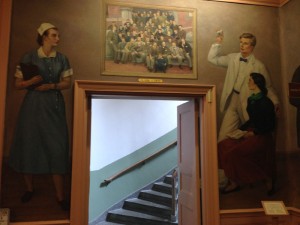Have you ever been reading or researching something and found a fact that relates to you personally? This happened to me just last week!
Down on A Level, a book title caught my eye: The Decisive Blow Is Struck turned out to be the very dramatic title of a reprint of the Proceedings of the Constitutional Convention of 1776 and the First Maryland Constitution (read the story behind the Maryland Constitutional Convention of 1776 online).

Inside was the list of men who wrote Maryland’s first state constitution. One of them was David Shriver. Was he related to our Shriver Hall? I looked in the library catalog and got five results, which I sorted by date. (Oh look, they’re all online!)
David Shriver was the Superintendent of the Cumberland Road, which went from Cumberland, MD to Wheeling, WV. Be glad that you didn’t have this job — Shriver went to take a look at it and found it “in a ruinous condition” (page 7). Bad news, especially since the road was 130 miles long.
In his report to President Monroe, Shriver also commented about the lack of money that Congress had given to this project (sound familiar?). We can do at least a superficial job, he said, but there really should be more money so that we can do a good job and make the road last longer. Good for David!
So was David Shriver, member of the Maryland Constitutional Convention and manager of the Cumberland Road, related to our Shriver Hall? Yes, he was! Men of Mark in Maryland: Biographies of Leading Men of the State will tell you about David and about his descendent — the Shriver who gave the money to build Shriver Hall — Alfred Jenkins Shriver. (Read this book online through the Internet Archive, or look at one of our print copies with the beautiful illustrations.)
What, exactly, was the relationship between David (1735-1826, who had nine children) and Alfred Jenkins Shriver (1867-1939)? Google pointed me to an ancestry site that included the surname “Shriver.” Continued clicks on the fathers’ names led me back four generations, from AJ himself to his dad — also named Albert — to grandfather William, great grandfather Andreas, and finally to great-great grandfather David.
How does this relate to me personally? I wondered what ever happened to the Cumberland Road and whether it still exists. Putting “Cumberland Road” in the catalog gives over 200 results, dating from 1805 to 2011. That 2011 book, The National Road and the Difficult Path to Sustainable National Development, is online; it’s a
“…comprehensive history of the first federally financed interstate highway, an approximately 600-mile span that joined Maryland, Pennsylvania, West Virginia, Ohio, Indiana, and Illinois in the nineteenth century. This book covers the road’s contribution to the cultural, economic, and administrative history of the United States, … and its revival in the twentieth century in the form of U.S. Route 40.“
Wait a minute: I live on Route 40!
Did I just find a book with an interesting title, which mentioned someone with the same name as one of our campus buildings, who I looked up in the catalog, to learn that:
- I live on one of the most famous roads in America, and
- the guy who helped to maintain it is the ancestor of Shriver Hall??
You never know where research is going to lead you!

By the way, have you been inside Shriver Hall lately? The research guide to Special Collections and Archives has a link to university records finding aids, and the word “shriver” is found in the link to Buildings and Grounds — Shriver Hall Murals records. When Alfred Jenkins Shriver died in 1939, he left money to the university to build a building, but only if some murals were painted and hung in the building. The Board of Trustees agreed. You should go over and look at the murals; they’re just beautiful.
